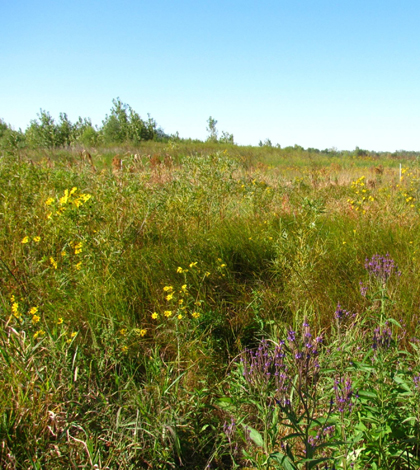Study backs building nitrate-filtering wetlands in farming landscapes

It turns out that combating nutrient runoff from agricultural lands might be as simple as knowing where to add a little water.
A new study led by Indiana University scientists suggests that introducing wetlands could help act as a buffer against harmful nutrient runoff from excessive fertilizer use.
The study is one of the first of its kind documenting how farmland conversion to natural habitats might help improve water quality.
Led by Christopher Craft, a Janet Duey professor in Rural Land Policy at IU Bloomington’s School of Public and Environmental Affairs, a team of a half dozen researchers began their research in 2008 after receiving funding from the U.S. Department of Agriculture. The goal of the study was to determine how soil processes such as denitrification and phosphorus sorption might impact water quality in various landscapes.
“We collected soil samples from different aged wetland restorations and from natural wetlands and also from riparian buffers. We brought them back to the lab and we incubated them under anaerobic conditions,” Craft said. “The restored wetlands or riparian buffers denitrified at much higher rates than [agricultural] lands do.”
Researchers determined that wetlands and riparian buffers are more effective at purging contaminants from the ground since waterlogged soils are capable of chemical processes that dry soils are not.
“There are a lot of processes that go on in the soil and the microbes are doing these things that help to clean up excess nitrogen. Farmers supply a lot of nitrogen of course to maximize crop yields, and not all of that gets taken up by the plants,” Craft said. “A lot of it runs off into rivers and streams. And if you have wetlands, you have that boundary between farmland and stream. There are microorganisms there that can basically take the excess nitrogen and convert it to nitrogen gas and put that back in the atmosphere where it belongs.”
Understanding the potential benefits of introducing wetlands into agricultural landscapes—specifically for heavy farming regions such as the Midwest—could have both local and global implications.
Nutrient runoff has been shown to cause widespread damage by polluting waterways and diminishing oxygen levels. Runoff from the Midwest has been linked to a large dead zone in the Gulf of Mexico, which is the result of excessive nutrients being transported by streams and rivers to the northern gulf. These dead zones have had detrimental effects on the fishing and shrimping industries in the region.
Scientists believe that runoff can be successfully corralled by incorporating wetlands and riparian buffers into agricultural landscapes with cooperation from both farmers and the U.S.
“I don’t mean take a lot of farmland out of production,” Craft said. “You can place them in strategic places at the edge of a farm before a stream and you can intercept a lot of these nitrates.”
Converting farmlands might help reduce runoff, but it comes with a cost. As the global population rises, demand for crops is set to increase.
Even strategically placed wetlands would necessitate the removal of crop lands to make room for the new habitats. The removal of crop lands would result in less crop yields, and ultimately, less money in farmers’ pockets.
One potential solution would be government subsidies that incentivize farmers for implementing wetlands on their land. However, researchers indicate that even if farmers were persuaded to restore natural lands to their plots, introducing these buffers would take time.
Craft estimates that it would take between 10 to 30 years of natural processes to transform sections of farmland into lands capable of sequestering nutrients.
But even if it takes decades, this study could be the first step in a transition to more responsible crop management in the future.
Indiana University’s study will be published in the journal Restoration Ecology.
Image: A restored wetland in Northwest Indiana (Credit: Christopher Craft)





0 comments